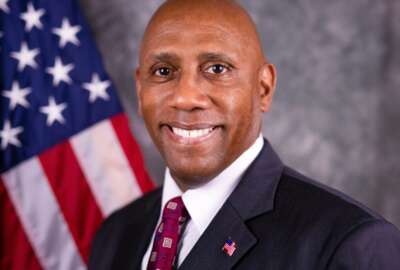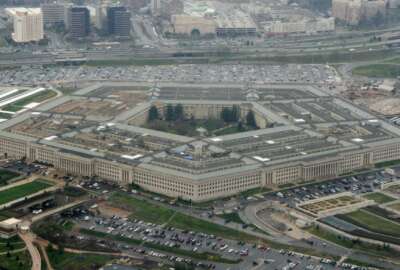

Hubbard Radio Washington DC, LLC. All rights reserved. This website is not intended for users located within the European Economic Area.
Last week's report from the Pentagon on defense industrial base competitiveness didn't sit well with services contractors.
Best listening experience is on Chrome, Firefox or Safari. Subscribe to Federal Drive’s daily audio interviews on Apple Podcasts or PodcastOne.
Last week’s report from the Pentagon on defense industrial base competitiveness didn’t sit well with services contractors. It recommended more merger oversight, modernizing intellectual property practices, and getting more companies into the DIB, among other things. The Federal Drive with Tom Temin spoke to Professional Services Council’s Executive Vice President for Policy, Stephanie Kostro, to hear what the report might’ve also said.
Interview transcript:
Tom Temin: Stephanie, good to have you back.
Stephanie Kostro: Thanks so much for having me, Tom.
Tom Temin: And the rebuttal on this from the Professional Services Council seem to say that the Defense Department, in looking at the DIB, should not forget that the DIB is also part of the general economy, and maybe thinks shouldn’t be bent quite so far to the advantage of the Pentagon?
Stephanie Kostro: That’s a very fair assessment. I would say, Tom, that although we are the Professional Services Council representing more than 400 government contractors, not all of them are in the defense industrial base; some of them are working with civilian agencies or international development. I would also say that we talked at length with some of our, I’ll call them sister associations — so those who represent more than just services, but also product. And the consensus was this report, entitled State of Competition within the defense industrial base, didn’t define the problem it was trying to address. There was no clarity in exactly what the issue is. Now, this report wasn’t in a vacuum. It was mandated by the White House in an executive order that came out just a year ago on promoting competition in the American economy. What is fascinating about that is this report from the Defense Department seems to ignore a couple of factors, one of which is when you’re talking about strengthening merger oversight, they are looking at it from a customer perspective — what happens when their defense industrial base consolidates, and what happens to pricing and availability. What they don’t acknowledge is that we are in a global marketplace. And so when we look at what is healthy for the American economy, you have to not only just look at what is happening with the Defense Department and what its available, you know, market share might be, but also what’s going on in the worldwide national security arena. And that report really doesn’t address what’s going on from that perspective. In addition — and I just mentioned how, you know, some of our member companies work not just with the Department of Defense, but with other agencies — the Department of Defense ignores the fact that in many cases, although they seem to be fixated on monopolies, is the monopsonistic tendency of the Department of Defense. In many cases, for some companies, the Defense Department is the market. So if you’re talking about distortionary factors coming into the economy, you have to consider the responsibility that DoD bears in what that marketplace looks like and what requirements, design requirements, technical requirements, staffing requirements, and then what happens on the back end after they’ve gotten the contract. It is relatively a monopsonistic market for many of these companies. And looking at DoD, placing the blame on market consolidation misses the point.
Tom Temin: Yeah, well, congratulations on saying monopsonistic. I’m not sure I could say it the first time around. But they have been, to their defense — I mean, no pun intended — they have been seeing this consolidation going back to, you know, when Jack Northrop brought up Leroy Grumman, I think they said from 51 airframe and platform manufacturers some years ago to only five today. I mean, from their point of view, it doesn’t look like it’s going in the right direction.
Stephanie Kostro: That’s true. But I think, if you look at what they’re comparing here, is 51 was the number I think they used, down to five in the span of a few decades. But those were major weapon systems. And I would argue, if you’re looking at major weapon systems or platforms, how many shipyards do you really need when you buy a nuclear-powered aircraft carrier once every 10 years or so? I mean, when you’re looking at the buying power of the Department of Defense, and when they look at the product side of it, you know, you’re really looking at what can manufacturing sustain and what is viable for that business. On the services side, you also see some consolidation, but I don’t believe nearly to the extent you’ve seen it in the products and the manufacturing side. And that’s why we at Professional Services Council wanted to take a strong stance that mergers are not bad. I don’t argue against oversight; I think responsible oversight is essential. But when I see headlines that say consolidation is the issue, I think you’ve misstated the problem statement here.
Tom Temin: We’re speaking with Stephanie Kostro, executive vice president for policy at the Professional Services Council. And I guess this is maybe unresolvable, and we’ll see what they actually do about it, although you do have a pretty active anti-trust anti-mechanism with this administration, so it’s hard to see how much more consolidation could take place, even if the companies wanted to. And in the meantime, you’re getting lots of reports about how hard the defense industrial base — everybody — is getting hit with cyber, as the whole Russian situation heats up.
Stephanie Kostro: We did receive — when I say we, it’s mostly defense contractors — received an alert last week on February 16 from the National Security Agency, talking about Russian tendencies and motives for hacking into defense contractors, particularly those who hold classified contracts but not limited to those. And so, they are trying to obtain sensitive U.S. defense Information and technology. And you know, this was a fairly extensive cyber advisory that went out. It went out across the government, but really focused on defense contractors. When you overlay that with what the Defense Department is trying to do with CMMC 2.0, or that’s the Cyber Maturity Model Certification process. They’ve just overhauled it or revamped it, they’ve consolidated, to use that word again, categories or levels of certification. We are still waiting to get a few more details on this whole certification process, understanding the rollout, understanding what companies will have to do. On that front, I would also argue that the Defense Department systems themselves are not immune to hacking. And so when we look at, you know, how contractors have to protect sensitive information and technology, I would say that is one side of the coin. The other side is obviously how the government itself is going to protect information and technology. And I think this is going to require back and forth engagements, collaboration, and really listening to each other in this domain.
Tom Temin: And did the NSA offer any remedies, or tell people what to do about it? Sometimes, like the Cybersecurity and Infrastructure — well not sometimes — every week CISA sends out detailed, like how to do the password better on your Cisco router, that kind of thing.
Stephanie Kostro: They did offer several pieces of their advisory and what to look out for. But I’ll also say that the government is trying hard, I believe, to put different kinds of tools and assistance in place to help various levels of companies. I would say, with this Biden-Harris administration’s push for small business, we do see a lot of tools being put in place to help small businesses with cyber hygiene. There is a project called Project Spectrum at the Department of Defense that helps small businesses with their cyber hygiene. You know, the adversary here gets a vote, right, and nothing is going to be foolproof or Russia-proof or whatever-proof. But I would say that, you know, tools and assistance can be put in place. But I go back to really needing to collaborate with the companies that face these things on a daily basis. The threat used to be from near peers that we could define the threat, we could have the ramp up time to build capabilities and capacities to counter that threat. For cyber, it’s a different game. You’re talking hundreds of thousands of attacks per day. And that really, when you’re looking at more than 200,000 companies in the defense industrial base, it’s a lot of attacks, and you’re never going to be perfect. I think tools and assistance and advice from the government to the contractors would be helpful in any form or fashion it comes over.
Tom Temin: And while we’re talking about government advisories, there’s still another report expected this week from defense on the supply chain. And what will that talk about?
Stephanie Kostro: Though, Tom, earlier we mentioned an executive order on competition, there was a second executive order on securing America’s supply chains and the Department of Defense received a tasking to look at sensitive, vulnerable areas, building on previous reports. This is another area where the Department of Defense has solicited industry feedback on things like forgings, castings, hypersonics, batteries, critical enablers, which are a lot of the services that our companies provide. And I think when you look at the whole of what we expect from an industry perspective in the report, I’m hoping that it reflects that feedback provided to DoD. I will tell you the report that came out last week on competition doesn’t make me positive about what we see in this report, but I’m gonna withhold judgment until I actually see the words on the paper.
Tom Temin: Alright. It’s like looking at the class picture. The first face you look for is your own, and then it came out okay. Stephanie Kostro is executive vice president for policy at the Professional Services Council. Thanks so much for joining me.
Stephanie Kostro: As always, Tom, it’s been a pleasure.
Copyright © 2024 Federal News Network. All rights reserved. This website is not intended for users located within the European Economic Area.
Tom Temin is host of the Federal Drive and has been providing insight on federal technology and management issues for more than 30 years.
Follow @tteminWFED



Each week, Defense Reporter Jared Serbu speaks with the managers of the federal government's largest department. Subscribe on PodcastOne or Apple Podcasts.
